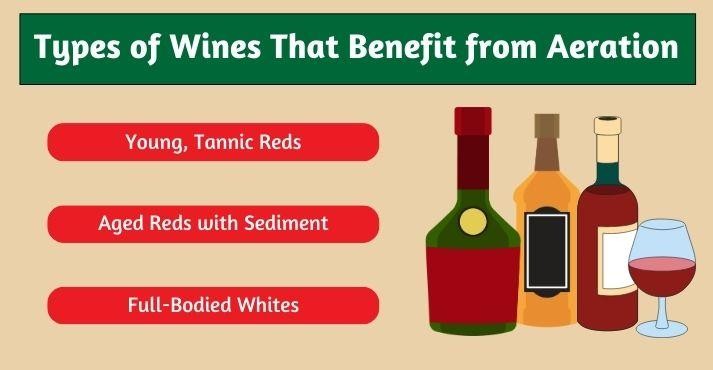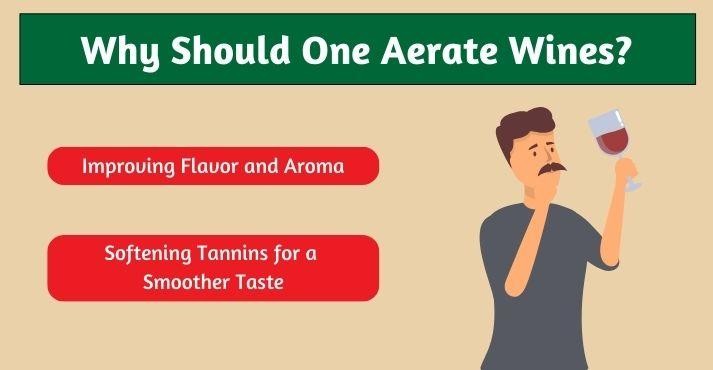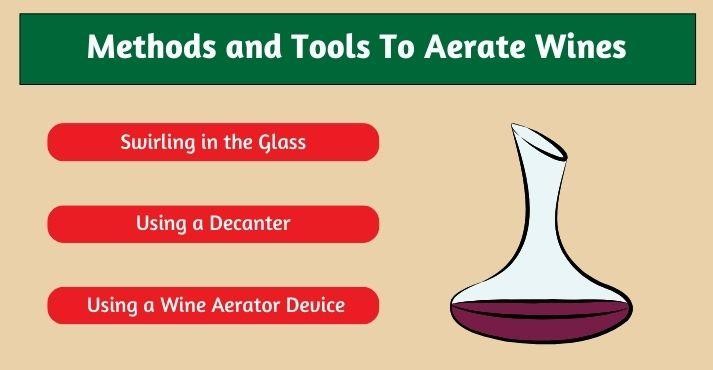Have you ever wondered why some wines taste flat right after opening while others explode with rich aromas?
The secret often lies in how much air they’re exposed to. This process, called wine aeration, is a fascinating intersection of science and sensory enjoyment.
Oxygen is key in unlocking a wine’s full bouquet and flavor profile, transforming your tasting experience from ordinary to extraordinary. But how does this transformation happen? The science lies in two fundamental processes: oxidation and evaporation.
These processes work together to soften harsh tannins, release hidden aromas, and neutralize off-putting odors.
In this comprehensive guide, we’ll explore the ins and outs of aerating wine, diving into methods, tools, and best practices to ensure you always get the most out of your bottle.
What is Wine Aeration?
At its core, wine aeration introduces oxygen to wine to enhance its flavor, aroma, and mouthfeel. When you open a bottle, the wine inside has been sealed off from the air, sometimes for years or even decades.
While this preservation ensures freshness, the wine can be tight or closed off when first poured. Aeration “wakes up” the wine, allowing it to express its true character.
How Wine Aeration Works
The magic of wine aeration lies in its ability to unlock flavors and aromas that might otherwise remain hidden. When exposed to oxygen, the wine undergoes chemical changes that can dramatically boost its taste and bouquet.
Comprehending the science behind this process can help wine enthusiasts make the most of their bottles, whether they’re savoring a bold Cabernet Sauvignon or a buttery Chardonnay.
Let’s explore what happens when wine meets oxygen and which types of wines benefit most from this transformative process.
What Happens When Wine Meets Oxygen?
Oxygen plays a dual role in transforming wine. Through two main processes—oxidation and evaporation; the wine’s flavor profile, aroma, and mouthfeel are augmented, creating a richer and more enjoyable tasting experience.
- Oxidation occurs when oxygen interacts with the chemical compounds in wine, such as tannins and phenols. This process softens the wine’s harsher characteristics, particularly in young or tannic wines, and allows its underlying flavors to emerge. For instance, a young Syrah might initially taste sharp and overly bitter. However, oxidation mellows these tannins after aeration, revealing velvety textures and complex black fruit, spice, or leather notes. This transformation can elevate a wine from being merely drinkable to truly enjoyable.
- Evaporation: Evaporation is the process by which volatile compounds in wine dissipate when exposed to air. These compounds often include:
- Sulfur-based compounds: Common in young wines, sulfur-based compounds can produce unpleasant odors, such as a “rotten egg” smell. Aeration helps eliminate these off-putting elements, leaving behind a cleaner aroma.
- Excess ethanol: The sharpness of a wine’s high alcohol content can mask its subtler flavors. As ethanol evaporates, the bouquet becomes more accessible, and the wine’s complexity comes to the forefront.
Types of Wines That Benefit from Aeration

Not all wines require aeration, but many benefit significantly from it. Let’s take a closer look at the types of wines that are best suited for this process:
- Young, Tannic Reds: Bold red wines with high tannin levels, such as Cabernet Sauvignon, Shiraz, and Malbec, often taste closed-off or overly aggressive when first opened. Aeration softens their tannins, balancing their flavors and making them more approachable. For example, a young Malbec might initially present overpowering notes of bitterness. After exposure to oxygen, those flavors mellow, allowing its lush blackberry, plum, and cocoa notes to shine.
- Aged Reds with Sediment: Older wines like Bordeaux or Barolo can develop sediment over time. Decanting these wines not only separates the sediment but also introduces oxygen to awaken their aged flavors. This is particularly important for older vintages, where subtlety and nuance might be hidden without proper aeration. When carefully decanting and allowing these wines to breathe, you reveal their intricate layers of dried fruit, earthiness, and spice.
- Full-Bodied Whites: While not as common, some full-bodied white wines, like oak-aged Chardonnay, can also benefit from light aeration. These wines often have rich, buttery textures and bold flavors that can become even more balanced and harmonious after exposure to air. A lightly aerated Chardonnay may showcase heightened notes of tropical fruit, vanilla, and toasted oak.
Why Aerate Wine?

Wine is a sensory experience, combining flavor, aroma, and texture to create an enjoyable moment with every sip. However, not every bottle reveals its best qualities immediately upon opening. This is where wine aeration plays a transformative role.
But why does aeration make such a difference? Let’s dive into the two main reasons why aerating wine is a must for any wine enthusiast.
Improving Flavor and Aroma
One of the most compelling reasons to aerate wine is its ability to amplify its aromatic compounds, enriching the bouquet and flavor profile.
When a bottle is first opened, especially a young red wine, the initial aroma can be muted or dominated by sharp alcohol notes. This is often because the wine has been sealed tightly for months or even years, limiting its exposure to oxygen.
Aeration breathes life into the wine, allowing its aromatic molecules to interact with the air. As these molecules are released, the wine’s true character emerges. For example:
- A young Zinfandel might initially smell closed-off, with an overpowering alcohol scent. After aeration, subtle black cherry, spice, and vanilla notes emerge, creating a more inviting and complex bouquet.
- A bold Shiraz, known for its intensity, can transform into a symphony of dark fruit, pepper, and smoky notes after being properly aerated.
Softening Tannins for a Smoother Taste
Another key benefit of aerating wine is the softening of tannins, which significantly impacts the wine’s texture and mouthfeel. Tannins are natural compounds found in grape skins, seeds, and stems.
They are responsible for the structure and longevity of red wines but can also create a bitter or astringent sensation, particularly in younger vintages and natural wines.
When wine is exposed to oxygen, the tannins undergo a chemical transformation, becoming less harsh and more integrated with the other components of the wine. This process mellows the wine, creating a smoother and more balanced drinking experience. For example:
- With its famously robust tannins, a young Nebbiolo can feel almost abrasive on the palate straight out of the bottle. After aeration, those tannins soften, revealing a velvety texture and intricate flavors of cherry, tar, and rose.
- Similarly, a Tempranillo might initially taste overly bitter or tight, but it develops into a harmonious blend of plum, leather, and tobacco with proper aeration.
Aeration improves the immediate drinking experience and allows you to appreciate the wine’s full complexity. It also helps you experience the subtle nuances that make each wine unique. This is especially true for bold reds, which often require breathing before thoroughly enjoying them.
How to Aerate Wine: Methods and Tools

The art of wine aeration is finding the right balance between oxygen exposure and timing. Whether you’re enjoying a casual wine glass at home or hosting a sophisticated dinner, knowing how to properly aerate wine can elevate its taste, aroma, and overall experience.
Thankfully, several effective methods and tools ensure your wine breathes just enough to unlock its full potential. From traditional techniques like swirling in a glass to modern innovations like wine aerators, there’s a method for every wine lover.
Here’s a detailed look at the most popular ways to aerate wine and when to use each.
1. Swirling in the Glass
Swirling is one of the simplest and most accessible ways to begin aerating wine. This technique requires no special equipment, just a glass with a wide bowl and a steady hand.
The act of swirling increases the wine’s surface area, allowing oxygen to mix with the liquid and activate the chemical processes of oxidation and evaporation.
Why It Works:
Swirling allows oxygen to interact with the wine’s aromatic compounds. For example, a young Pinot Noir might initially release sharp, acidic notes.
After a few seconds of aeration, you’ll notice softer, fruit-forward aromas like cherry or raspberry taking center stage. This simple action also helps reduce any sulfur-based compounds, eliminating unpleasant odors.
When to Use It:
Swirling works best for:
- Lighter red wines, Such as Pinot Noir or Gamay, require minimal aeration to reveal their flavors.
- Delicate whites, Such as Sauvignon Blanc or Riesling, where too much aeration could dull their crispness.
2. Using a Decanter
Wine decanting is a time-honored method of aerating wine, especially for young, tannic reds or aged wines with sediment. A decanter is a specially designed vessel with a wide base that spreads the wine, exposing it to more oxygen over time.
As you pour the wine from its bottle into the decanter, you introduce oxygen by pouring itself.
Why It Works:
The large surface area of a decanter allows oxygen to mix thoroughly with the wine, accelerating the oxidation process.
Additionally, decanting can separate sediment, which is common in aged wines like vintage Bordeaux or Barolo. Removing the sediment ensures a smoother, more enjoyable drinking experience.
When to Use It:
Decanting is ideal for:
- Young, tannic wines, Such as Cabernet Sauvignon, Shiraz, and Malbec, benefit from 30-60 minutes of aeration to soften their bold structures.
- Aged reds with sediment: Wines stored for over 10 years may have sediment that needs to be separated during the decanting process.
Steps for Decanting:
- Choose the right decanter: For young wines, use a wide base or a narrower one for older vintages.
- Pour carefully: Tilt the bottle as you pour to avoid stirring up sediment.
- Let it breathe: Allow the wine to sit for 30-60 minutes, tasting periodically to ensure it hasn’t been over-aerated.
3. Using a Wine Aerator Device
For those who value efficiency and precision, a wine aerator is a modern tool that makes aerating wine quick and hassle-free. These devices are designed to instantly expose the wine to oxygen as it’s poured, using built-in channels or mechanisms to increase air contact.
Why It Works:
A wine aerator creates a controlled flow of wine that mixes with air during pouring. This instant oxygenation eliminates waiting for the wine to breathe in a decanter. Some advanced aerators even mimic the effects of prolonged aeration, making them ideal for impatient wine enthusiasts.
When to Use It:
Wine aerators are perfect for:
- Young, bold reds: Aerators soften tannins in wines like Zinfandel or Syrah.
- Quick aeration needs: An aerator offers an efficient alternative when you don’t have time to decant.
- On-the-go wine lovers: Compact aerators are perfect for picnics, parties, or other occasions where portability matters.
Types of Wine Aerators:
- Handheld Aerators: These devices require holding the aerator over the glass as you pour the wine. They’re compact and easy to use.
- In-Bottle Aerators: These are attached directly to the wine bottle, allowing for smooth pouring and aeration in one step.
- Electric Aerators: These advanced tools automatically aerate wine as they dispense it, offering a luxurious, hands-free experience.
Choosing the Right Method
Each method of wine aeration serves a specific purpose and is best suited for certain types of wines or occasions. Here’s a quick comparison to help you decide:
- Swirling: Best for quick, minimal aeration of lighter wines.
- Decanting: Ideal for young reds and aged wines with sediment; requires more time.
- Wine Aerators: Perfect for quick, efficient aeration, especially for bold reds.
Decanting Wine vs. Aerating Wine
Decanting and aerating wine are two ways to improve its taste, similar to letting it mix with air. However, they are used for different types of wine and have different benefits.
Decanting wine is best for older wines. Older wines sometimes have little sediment, solid pieces that settle at the bottom of the bottle over time. These sediments don’t taste good and can make the wine cloudy.
When you pour wine into a decanter, the sediment separates from the liquid, allowing the wine to breathe. This process also helps aged wines open up and show their full flavors.
Using a wine aerator is great for younger wines. Because these wines haven’t aged as long, their flavors and smells need to be fully developed.
A wine aerator lets air mix with the wine as you pour it. This happens very quickly and helps to bring out the wine’s aroma and taste in just a few seconds. It’s a simple tool that works well when you need more time to decant.
In short, decanting is better for older wines with sediment, and aerating is perfect for young wines that need a quick boost. Both methods improve your wine-drinking experience but in different ways.
Over-Aeration: Losing Flavor and Aroma
While exposing wine to air is good, too much air can ruin its taste. This happens when a wine gets over-aerated. When wine has been in contact with air for too long, its flavors and smells can fade.
Instead of tasting bright and delicious, the wine might become flat or boring. It’s like leaving a soda open too long; eventually, it loses its fizz.
To avoid over-aerating your wine, follow these simple steps:
- Limit aeration time. Letting them sit out for 1 to 2 hours is enough for most wines.
- Taste as you go. After a while, take a sip to check if the wine tastes better. You’ll know it’s ready when the flavors feel balanced and smooth.
How to Avoid Over-Aerating Wine?
Here are some easy tips to keep your wine from getting too much air:
- Set a timer. Decide how long you want to aerate your wine and remember to check the clock.
- Taste-test often. Take small sips during the aeration process to see when the wine tastes right. If it tastes great, stop aerating.
- Know the type of wine. Some wines, like delicate white or older reds, don’t need much aeration.
Conclusion
Wine aeration is a transformative practice that unlocks a wine’s full potential. Understanding the science behind aerating wine and choosing the right tools, whether a decanter, a wine aerator, or simple swirling, elevates every pour.
Southeast Asia’s vibrant wine culture has involved these techniques, ensuring that every bottle delivers its best, from bold reds to full-bodied whites.
Next time you open a bottle, take a moment to let it breathe—you’ll be rewarded with a more prosperous, smoother, and more aromatic experience.





























